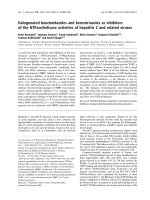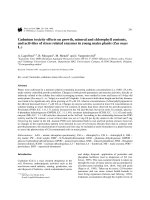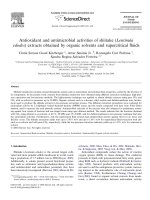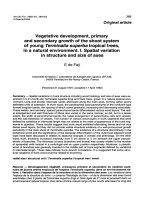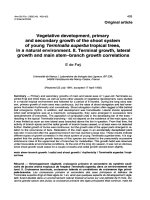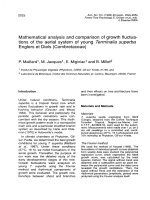Antioxidant and antibacterial activities of Terminalia superba Engl. and diels (Combretaceae) bark extracts
Bạn đang xem bản rút gọn của tài liệu. Xem và tải ngay bản đầy đủ của tài liệu tại đây (461.96 KB, 11 trang )
Int.J.Curr.Microbiol.App.Sci (2018) 7(7): 2836-2846
International Journal of Current Microbiology and Applied Sciences
ISSN: 2319-7706 Volume 7 Number 07 (2018)
Journal homepage:
Original Research Article
/>
Antioxidant and Antibacterial Activities of Terminalia superba Engl.
and Diels (Combretaceae) Bark Extracts
Kougnimon Fifamè Espérance Elvire1*, Akpovi Dewanou Casimir1,
Dah-Nouvlessounon Durand2, Boya Bawa2, Baba Moussa Lamine2 and Loko Frédéric1
1
Laboratoire de Recherche en Biologie Appliquée (LARBA/ EPAC/UAC) 01BP 2009
Cotonou, Bénin
2
Laboratoire de Biologie et de Typage Moléculaire en Microbiologie, Faculté des Sciences et
Techniques, Université d’Abomey-Calavi, 05 BP 1604 Cotonou, Bénin
*Corresponding author
ABSTRACT
Keywords
Terminalia
superba,barks,
Antibacterial
activity,
Antioxidant activity
Article Info
Accepted:
20 June 2018
Available Online:
10 July 2018
Terminalia superba (T. superba) is locally used for the treatment of various diseases,
including diabetes mellitus, gastroenteritis, female infertility, abdominal pains, bacterial,
fungal and viral infections. This study aimed to ascertain the antioxidant and antimicrobial
activities of ethanolic and hydro-ethanolic extracts of T. superba barks. Total phenols,
flavonoids, and tannins were measured in the extracts by a spectrophotometry method. The
DPPH method was used to evaluate extracts antioxidant activity. The antibacterial activity
was evaluated using broth micro-dilution method in vitro on Staphylococcus aureus
isolated clinical strains from three skin infections (buruli ulcer, furuncles and abscesses)
and a Staphylococcus aureus reference strains (Staphylococcus aureus ATCC 29213).
Clinical strains were multi drug resistant with or without a virulence factor (PantonValentine Leukocidin (PVL).The phytochemical screening of ethanolic and hydroethanolic extracts of T. Superba barks revealed the presence of tannins (catechic and
gallic), flavonoids, saponins, free anthracene derivatives, reducing compounds, mucilage.
Ethanolic and hydro-ethanolic extracts showed antioxidant activities. Both extracts had
antibacterial activities on Staphylococcus aureus ATCC 29213 and S. aureus isolated from
skin infections. This study shows that T. superba has high antibacterial and antioxidant
activities.
Introduction
Medicinal plants are recognized as the most
popular form of alternative medicine
(Ogbonnia et al., 2011). Herbal prescriptions
and natural remedies are commonly employed
in developing countries for the treatment of
various diseases, this practice being an
alternative way to compensate for some
perceived
deficiencies
in
orthodox
pharmacotherapy (Zhu et al., 2002). In Benin,
they offer a wider available and affordable
alternative to pharmaceutical drugs and
natural food supplements.
2836
Int.J.Curr.Microbiol.App.Sci (2018) 7(7): 2836-2846
To face the increase in many microbial
pathogens resistance against conventional
antibiotics, it is essential to seek other drugs
with wide spectrum anti-microbial activities.
Therefore, research must be directed to
biologically active extracts and compounds
from plant species to fight microbial diseases
(Chanda et al., 2011). A high number of
medicinal plants have been recognized as an
important resource of natural antimicrobial
compounds (Mahady, 2005). Moreover, many
medicinal plants have an antioxidant activity
that is attracting more and more the attention
of several research teams for its role in the
fight against several diseases such as cancer,
atherosclerosis, cerebro-vascular condition,
diabetes, hypertension, and Alzheimer's
disease (Vârban et al., 2009). Numerous
physiological and biochemical processes
produced oxygen-centered free radicals and
other reactive oxygen species (Stankovic et
al., 2011). Antioxidants are capable of
scavenging free radicals, which can oxidize
many biological macromolecules (DNA,
proteins, and lipids) in cells and tissues.
Phytochemical compounds exhibit several
activities such as antioxidant, antiinflammatory, anti-hepatotoxic, anti-tumoral
and anti-microbial (Zengin et al., 2011).
This study is focused on Terminalia superba
Engl. & Diels (Combretaceae) which is used
by various traditional healers for the treatment
of bacterial, fungal and viral infections. The
main objective of this work is to perform a
phytochemical screening in order to evaluate
the phenolic composition and determine the
potential anti-radical activity and antibacterial
activity of two extracts of T.superba.
Materials and Methods
Plant material
The T.superba barks were collected in Itchèdé,
Toffo Forest at Adja-Ouèrè (Benin). The
identification of the plant was confirmed at the
National Herbarium in Benin. The barks dried
at 25°C were ground into a fine powder.
Microorganisms
The antimicrobial activity of T. superba
extracts was tested against a standard strain
(Staphylococcus aureus ATCC 29213) and
Staphylococcus aureus strains isolated from
various types of skin infections such as buruli
ulcer, furuncles and abscesses. Sixteen (16)
clinical strains were Multi Drug Resistant and
produced Panton Valentine Leukocidin (PVL)
virulence factor. Twenty-three (23) clinical
strains were Multi Drug Resistant without
Panton Valentine Leukocidin (PVL) virulence
factor (Sina et al., 2013). The tested strains
were initially cultured in Muller-Hinton broth
containing 20% glycerol and were stored at 80˚C.These microorganisms were obtained
from the Laboratory of Biology and Molecular
Typing in Microbiology (University of
Abomey-Calavi, Benin, West Africa).
Preparation of crude extracts
The extracts were prepared according to the
method described by Talbi et al., (2015).
Fifty grams (50 g) of powder were dissolved
in 500 ml ethanol 96% (ethanolic extract) and
500 ml ethanol 70% (hydro-ethanolic extract).
Seventy-two hours (72h) after, the macerate
was filtered with hydrophilic cotton and
Whatman filter paper and was evaporated to
dryness at 40°C using a Rotavapor. The
resulting powder was stored in a refrigerator at
8°C until use.
Phytochemical analysis
Qualitative phytochemical screening of
T.superba was carried out on the extracts
(ethanolic and hydro-ethanolic), using the
standardly employed precipitation and
coloration reactions as described by Houghton
and Raman (1998).
2837
Int.J.Curr.Microbiol.App.Sci (2018) 7(7): 2836-2846
Antioxidant activity: DPPH free radical
scavenging assay
The quantitative evaluation of antioxidant
activity was based on the methodology
proposed by Brand-Williams et al., (1995).
DPPH nitrogen radical scavenging assay was
performed based on reduction of 2, 2diphenyl-1-picrylhydrazl (DPPH) recorded at
517 nm according to a standard method.
Ascorbic acid was used as standard.
Percentage of inhibition/ scavenging (% AA)
was calculated by the following formula:
Where, A white is the absorbance of the white
reaction mixture, and
A sample is the absorbance of the sample.
The percentage of inhibition of DPPH was
plotted against the extracts concentration to
obtain IC50. IC50 is the concentration of
extracts which can decrease the initial DPPH
concentration by 50 %. Lower IC50 value
shows higher radical scavenging activity.
Antibacterial activity of ethanolic and
hydro-ethanolic extracts of T. superba
Antimicrobial susceptibility testing
Antimicrobial susceptibility was evaluated
using the Kirbye-Bauer disk diffusion method
on agar Mueller-Hinton (bioMérieux, Marcy
l'Etoile, France) in accordance with The
Clinical and Laboratory Standards Institute
[CLSI] (2015), the following 18 antimicrobial
agents were tested: Penicllin G (6µg),
oxacillin (5μg), Ofloxacin (5µg), cefoxitin
(30μg), gentamicin (10µg), tobramycin
(10μg), kanamycin (30μg), vancomycin (5μg),
teicoplanin (15μg), fusidic acid (10μg),
fosfomycin
(50μg),
rifampicin
(5μg),
trimethoprim/
sulfamethoxazole
(1.25/
23.75μg), erythromycin (15μg), lincomycin
(30μg), pristinamycin (15μg), linezolid (30μg)
and tetracyclin (30 μg).
Panton-Valentine
identification
Leukocidin
(PVL)
All S. aureus isolates were investigated for the
carriage of PVL. For the phenotypic detection
of toxins radial gel immunodiffusion was
performed. The production of PantonValentine Leukocidin (PVL) were evidenced
from culture supernatants after 18 h of growth
in Yeast Casamino-acid Pyruvate (YCP)
medium (Gauduchon et al., 2001) by radial
gel immunodiffusion in 0.6% (wt/vol) agarose
with component-specific rabbit polyclonal and
affinity-purified antibodies (Prévost et al.,
1995 Gravet et al., 1998).
Determination of the minimum inhibitory
concentration (MIC) and the minimum
bactericidal concentration (MBC) of
T.superba stem bark extracts
Hydro-ethanolic and ethanolic extracts of T.
superba bark were reconstituted in distilled
water at 80 mg/ml. The prepared solutions
were sterilized by filtration using filtersyringes on 0.22 μm Millipore membrane. The
sterility of the stock solutions was verified by
culturing aliquots of each solution on Mueller
Hinton media, incubated at 37°C for 24 up to
48 hours.
The microdilution method (quantitative
activity) was used for the determination of
MIC. The MIC was defined as the lowest
concentration of extracts inhibiting visible
bacterial growth after 18 or 20 h incubation at
37°C (Kouitcheu et al., 2013). Into each well,
100 μL of broth Muller Hinton enriched with
glucose solution 1% and 5% red phenol
solution was added. Then, 100 μL of each
extract was added in every first well of the
microplate.
2838
Int.J.Curr.Microbiol.App.Sci (2018) 7(7): 2836-2846
Geometric dilutions ranging from 80 to 0.078
mg/ml were carried out and subsequently,
100μL of media containing 106UFC/ml of the
indicator strain was added to all wells to yield
40 to 0.039 mg/ml of concentration. The
plates were then incubated at 37°C for 24 h.
The experiment was done in triplicate. A color
change from red to yellow was indicative of
bacterial growth.
To obtain the MBC, 20 μL of each well
colored red was spotted on Muller Hinton agar
and incubated at 37°C for 24 h. The MBC
were
determined
by
the
minimum
concentration that allowed less than 0.01% of
bacterial growth.
The antibiotic power (AP) of each extract was
thereafter calculated with the formula
CMB/CMI. According to the values obtained
in inhibition tests, the extracts was classified
as bactericidal when MBC/MIC ≤ 4 and
bacteriostatic when MBC/MIC >4
Statistical analysis
The data were analyzed with excel and SPSS
17 software. Calibration curves were carried
out with Excel. Means and standard deviations
were determined. For the comparison of the
variances and means of the different
modalities, the Student Levene and t tests
were used respectively after verification of
normality (Skewness and Kurtosis).
In the case where the normality hypothesis is
not verified, a non-parametric test has been
carried out in order to compare the modalities
of variables. P values<0.05 were significant.
Results and Discussion
Phytochemical screening
Table 1 illustrated the phytochemical
screening of T. superba bark crude extracts
(ethanol, hydro-ethanol).
Qualitative analysis of T.superba barks crude
extracts (ethanol, hydro-ethanol) reveals
various phytochemicals compounds: tannins
(Cathetic, Gallic), flavonoids, saponins, free
anthracenics, reducing compounds and
mucilage.
Previous phytochemical studies on T.superba
bark identified several compounds, including
tannins, flavonoids (Dongmo et al., 2006;
Kouakou et al., 2013; Goze et al., 2014; Ahon
et al., 2011), saponosides (Kouakou et al.,
2013; Goze et al., 2014; Ahon et al., 2011)
and many reducing compounds (Kouakou et
al., 2013; Goze et al., 2014).
Contrary to our findings, coumarins and
quinone (Kouakou et al., 2013; Goze et al.,
2014), triterpenoids and sterols (Kouakou et
al., 2013; Goze et al., 2014; Ahon et al.,
2011), alkaloids (Ahon et al., 2011) were
reported in T. superb bark. The environment,
periods of harvest of organs, stocking
conditions of organs and extract solvents may
influence the synthesis and expression of
phytochemical components in the plant
(Sauvion et al., 2013).
Antioxidant activity
Table 2 shows IC50 of T.superba extracts and
standards.
The hydro-ethanolic extract (IC50 = 11.60
μg/ml) has a higher DPPH free radicalscavenging activity than the ethanolic extract
(IC50 = 34.72 μg/ml); however, the scavenging
activity of the hydro-ethanolic extract is lower
than that of the antioxidant standard ascorbic
acid (9.62 μg/ml).The IC50 of the hydroethanolic extract is 2.99-fold lower than that
of ethanolic extract and 1.20-fold higher than
that of ascorbic acid. The free radicalscavenging capacity of the hydro-ethanolic
extract of T. superba bark is higher than that
of the ethanolic extract. This can be attributed
2839
Int.J.Curr.Microbiol.App.Sci (2018) 7(7): 2836-2846
to the higher concentration of phenolic
compounds in the hydro-ethanolic extract of
T. superba barks. Previous reports showed a
correlation between the antioxidant activity
and the amount of total phenolic content
(Negro et al., 2003). Phenolic compounds are
hydrogen donors capable of directly
scavenging free radicals and reducing
oxidative damage (Wintola et al., 2015). In
other medicinal plant extracts, these
compounds also activated endogenous
antioxidant systems and inhibited the lipid per
oxidation of human erythrocytes (Ribeiro et
al., 2015). The antioxidant activity of T.
superba bark was also determined by Momo
et al., (2009).
Table.1 Phytochemical analysis T. superba bark extracts (ethanolic and hydro-ethanolic)
Tannins
Chemical groups
Alkaloids
Catechin tannins
Gallic tannins
Flavonoids
Anthocyanins
Leucoanthocyanins
Coumarin
Quinone derivatives
Mucilages
Reducting compound
Saponins
Anthracenics
derivate
Triterpenes
Steroids
Cyanogenic derivate
Free anthracenic
Combine
anthracenic
o-hétérosides
c- hétérosides
Cardiotonic glycoside
EE
++
HEE
+++
++
+++
+
++
++
+
H= 1.5 cm
IM= 4/10
+
++
++
++
+
H = 1.9cm
IM= 4/10
+
-
-
-
-
-: absence; +: present in low concentration; ++: present in moderate concentration; +++ present in high
concentrations; EE: ethanolic extract; HEE: Hydro-ethanolic extract, H: Height of the foam; IM: Foam Index.
2840
Int.J.Curr.Microbiol.App.Sci (2018) 7(7): 2836-2846
Table.2 IC50 of the ethanolic and hydro-ethanolic extracts of T.superba barks compared with the
antioxidant standards ascorbic acid
EE
HEE
AA
IC50 (µg/ml)
34.72
11.60
9.62
Calibration curve
Y= 18,80 ln (x) -16,69
Y= 14,27 ln (x) + 14,63
Y= 14,16 ln (x) -17,91
R2
0.947
0.935
0.885
EE = Ethanolic extract; HEE= Hydro-ethanolic extract; AA = Ascorbic acid; IC50: Concentration of extracts can
inhibit 50% of DPPH radicals
Table.3 Antimicrobial susceptibility
Drug(s)
Fusidicacid (10µg)
Cefoxitin (30µg)
Erythromycin (15µg)
Fosfomycin (50µg)
Gentamicin (10µg)
Kanamycin (30µg)
Lincomycin (15µg)
Linezolid (10µg)
Ofloxacin (5µg)
Oxacillin (5µg)
PenicllinGG (6µg)
Pristinamycin (15µg)
Rifampicin (5 µg)
Teicoplanin (15µg)
Tetracyclin (30 µg)
Tobramycin (10µg)
Trimethoprim/sulfamethoxazole
(1,25/23,75 µg)
Vancomycin (5µg)
PVL + (n = 16)
Number (%)
0
5 (31,25)
12 (75)
0
6 (37,5)
12 (75)
5 (31,25)
0
4 (25)
13 (81,25)
16 (100)
4 (25)
4 (25)
2 (12,5)
3 (18,75)
9(56,25)
7 (43,75)
PVL – (n= 23)
Number (%)
0
6 (26,09)
14 (60,87)
0
16 (69,57)
8 (34,78)
7 (30,43)
0
6 (26)
6(26,09)
23 (100)
5 (22)
11 (47,83)
4 (17,39)
5(21,74)
4(17,39)
10 (43,48)
0
Total (n= 39)
Number (%)
0
11 (28,21)
26 (67,67)
0
22 (56,41)
20 (51,28)
12 (30,77)
0
10 (26)
19 (48,71)
39 (100)
9 (23)
15 (38,46)
6(15,38)
8 (20,51)
13(33,33)
17 (43,59)
0
P
0,725
0,357
0,047
0,013
0,957
0,939
0,001
0,812
0,150
0,677
0,820
0,011
0,987
0
-
Table.4 Comparative study of the bactericidal activity of ethanolic and hydroethanolic extracts
on reference strain
EE
S.aureus ATCC 29213
MIC
0.078
HEE
MBC
0.078
AP
1
MIC
0.078
MBC
0.078
AP
1
S. aureus ATCC 29213= Staphylococcus aureus ATCC 29213; MIC = Minimal Inhibitory Concentration (mg/ml);
MBC = Minimal Bactericidal Concentration (mg/ml);AP (CMB/CMI) = antibiotic power; EE: ethanolic extract;
HEE: hydro-ethanolic extract.
2841
Int.J.Curr.Microbiol.App.Sci (2018) 7(7): 2836-2846
Table.5 Comparative study of the bactericidal activity of ethanolic and hydroethanolic extracts
on LPV + strains
EE
MIC
1.25
1.25
1.25
1.25
1.25
1.25
1.25
1.25
0.625
0.625
0.625
0.625
2.5
1.25
2.5
1.25
HEE
MBC
AP
MIC
MBC
AP
S. aureus PVL+
1
2.5
2
0.625
0.625
1
2
2.5
2
0.625
0.625
1
3
5
4
0.625
0.625
1
4
10
0.625
1.25
2
8*
5
10
0.312
0.625
2
8*
6
10
0.312
0.625
2
8*
7
2.5
2
0.312
0.625
2
8
5
4
0.312
0.625
2
9
5
0.312
0.625
2
8*
10
5
0.312
0.625
2
8*
11
5
0.312
2.5
8*
8*
12
2.5
4
0.312
0.625
2
13
20
0.312
1.25
4
8*
14
20
0.625
5
16*
8*
15
10
4
0.312
0.312
1
16
20
0.312
2.5
16*
8*
p= 0.028
MIC = Minimal Inhibitory Concentration (mg/ml); MBC = Minimal Bactericidal Concentration (mg/ml); AP
(CMB/CMI) = antibiotic power; AP without* = bactericidal power; AP With * = bacteriostatic power; S. aureusP
VL+ =PVL positive Staphylococcus aureus; EE: ethanolic extract; HEE: hydro-ethanolic extract.
Table.6 Comparative study of the bactericidal activity of ethanolic and
hydroethanolic extracts on LPV- strains
S. aureus MR/PVL-
EE
MIC
HEE
MBC
1
1.25
10
2
1.25
3
4
5
6
7
8
9
10
11
12
13
14
15
1.25
0.625
0.625
0.625
0.625
0.625
0.625
0.312
0.312
0.312
0.312
0.312
0.312
AP
MIC
MBC
AP
0.312
2.5
1.25
8*
1
0.312
0.625
8*
2
2.5
5
1.25
1.25
5
5
5
0.625
0.625
2.5
5
2.5
0.625
2
8*
2
2
8*
8*
8*
2
2
8*
16*
8*
2
0.312
0.312
0.312
0.312
0.312
0.312
0.312
0.312
0.312
0.312
0.312
0.312
0.312
0.625
0.625
0.625
0.625
2.5
0.625
0.312
0.312
0.312
0.312
2.5
0.312
0.312
2
2
2
2
8*
2
1
1
1
1
8*
1
1
2842
Int.J.Curr.Microbiol.App.Sci (2018) 7(7): 2836-2846
16
0.312
0.625
2
0.312
0.312
1
17
18
19
20
21
22
0.312
0.312
0.312
0.312
0.312
0.312
2.5
2.5
1.25
1.25
1.25
2.5
8*
8*
4
4
4
8*
0.156
0.156
0.156
0.156
0.156
0.156
0.312
1.25
0.312
0.312
0.312
1.25
23
0.312
2.5
8*
0.156
0.312
2
8*
2
2
2
8*
2
p= 0,032
MIC = Minimal Inhibitory Concentration; MBC = Minimal Bactericidal Concentration; AP (CMB/CMI)= antibiotic
power; AP without* = bactericidal power; AP with* = bacteriostatic power;S. aureusMR/PVL- = PVL negative
multi-resistant Staphylococcus aureus; EE: ethanolic extract; HEE: hydro-ethanolic extract.
Antibacterial activity of ethanolic and
hydro-ethanolic extracts of T. superb on the
clinical S. aureus strains and the reference
strains
Table 3 shows the antimicrobial Susceptibility
Panton-Valentine Leukocidin is present in 16
S. aureus isolates.
There is a wide range in the susceptibility of
the isolates to the various antibiotics
examined. All of the strains are resistant to
benzyl penicillin, while other antibiotics
(vancomycin, fusidic acid, fosfomycin, and
linezolid) are active against some of the
strains (Table 3).
Tables 4, 5 and 6 show the comparative study
of the antibacterial activity of ethanolic and
hydro-ethanolic extracts on the clinical and
reference strains. The minimum inhibitory
concentration (MIC) values of both extracts
against Staphylococcus aureus ATCC 29213
(reference strain) is 0.078 mg/ml.
The minimum bactericidal concentration
(MBC) values of both extracts observed
against Staphylococcus aureus ATCC 29213
(reference strain) is 0.078 mg/ml. AP
(MBC/MIC)=1 for both T. superb extracts.
Results shows that both ethanolic extract and
hydro-ethanolic extract are bactericidal on the
reference strain (Table 4). The minimum
inhibitory concentration (MIC) values of
ethanolic extract against Staphylococcus
aureus PVL+ strains ranged from 0.625 to 2.5
mg/ml.
The
minimum
inhibitory
concentration (MIC) values of hydroethanolic extract against Staphylococcus
aureus PVL+ strains ranged from 0.312 to
0.625 mg/ml.
Ethanolic extract is bacteriostatic on 9
(56.25%) S.aureus PVL + strains and is
bactericidal on 7 (43.75%) S.aureus PVL+
strains.
Hydro-ethanolic extract is bacteriostatic on 3
(18.75%) S.aureus PVL+ strains and is
bactericidal on 13 (81.25%) S.aureus PVL+
strains. Hydro-ethanolic extract is more
significantly more bactericidal than ethanolic
extract (p=0.028) ( Table 5).
The minimum inhibitory concentration (MIC)
values of ethanolic extract observed against
Staphylococcus aureus PVL- strains ranged
from 0.312 to 1.25 mg/ml. The minimum
inhibitory concentration (MIC) values of
hydro-ethanolic extract observed against
Staphylococcus aureus PVL+ strains ranged
from 0.156 to 0.312 mg/ml.
Ethanolic extract is bacteriostatic on 12
2843
Int.J.Curr.Microbiol.App.Sci (2018) 7(7): 2836-2846
(52.17%) Staphylococcus aureus PVL strains and is bactericidal on 11 (47.83%)
Staphylococcus aureus PVL -strains. Hydroethanolic extract is bacteriostatic on 5
(21.74%) Staphylococcus aureus PVL- strains
and is bactericidal on 18 (78.26%)
Staphylococcus aureus PVL- strains. Hydroethanolic extract is significantly more
bactericidal than ethanolic extract (p= 0.032)
(Table 6).
T. superba bark extracts (ethanolic and hydroethanolic) possessed bactericidal activity.
Flavonoids, saponins and tannins were
reported to have antimicrobial activity.
Phenolic compounds also have antimicrobial
activity via several mechanisms, including
adsorption and disruption of microbial
membranes,
ion
deprivation,
enzyme
interaction, and interaction with membrane
transporters (Favela-Herna Ândez et al.,
2015;Cowan, 1999).Previous studies have
indicated that T.superba has antimicrobial
activities against several microorganisms
(Kuete et al., 2010; Tabopda et al., 2009; Kra
et al., 2015; Ahon et al., 2011).
In conclusion, T. superba contains chemical
molecules such as tannins (catechics, gallic),
alkaloids, flavonoids, saponosides, mucilages,
reducing compounds, free anthracenics. These
active ingredients are used in the treatment of
certain human pathologies. We showed here
that T. superb extracts had antibacterial
activities on Staphylococcus aureus ATCC
29213 and S. aureus isolated from skin
infections indicating that T. superba is a
potential source of natural antioxidants and
antimicrobials compounds.
Acknowledgements
The authors are grateful to Garcia Christopher
(Montreal University, Faculty of Medicine)
for his critical reading of this paper.
References
Ahon, M. G., J. M. Akapo-Akue, M. A. Kra,
J. B. Ackah, N. G. Zirihi and Djaman J.
A. 2011. Antifungal activity of the
aqueous and hydro-alcoholic extracts of
T. superbEngl and Diels on the in vitro
growth of clinical isolates of pathogenic
fungi. Agriculture and Biology Journal
of North America. 2(2): 250-257.
Brand-Williams, W., M. E. Cuvelier and
Berset C. 1995. Use of a free radical
method to evaluate antioxidant activity.
Lebensmittel-wissenschaft Technologie.
28: 25-30.
Chanda, S., K. Rakholiya and Nair R. 2011.
Antimicrobial activity of Terminalia
catappa L. leaf extracts against some
clinically
important
pathogenic
microbial strains. Chinese Medicine. 2:
171-177.
Cowan, M. M. 1999. Plant products as
antimicrobial
agents.
Clinical
Microbiology Reviews. 12 (4): 5646582.
Dongmo, A. B., J. G. Beppe, T. Nole and
Kamanyi A. 2006. Analgesic activities
of the stem bark extract of Terminalia
superba Engl. Et Diels (Combretaceae).
Pharmacologyonline. 2: 171-177.
Favela-Hernandez, J. M., A. F. ClementeSoto, I. Balderas-RenterõÂa, E. GarzaGonzaÂlez and Camacho-Corona M. R.
2015. Potential Mechanism of Action of
3'-Demethoxy-6-O-demethylisoguaiacin on Methicillin Resistant
staphylococcus aureus. Molecules. 20
(7): 12450- 12458.
Gauduchon, V., S. Werner, G.Prévost,
H.Monteil and Colin D. A. 2001. Flow
cytometric determination of PantonValentine leucocidin S component
binding. Infectection and Immunity.
69(4): 2390–2395.
Goze, N. B., K. L. Kouakou, N. M. Bléyéré,
B. A. Konan, K. A. Amonkan, K. J. C.
2844
Int.J.Curr.Microbiol.App.Sci (2018) 7(7): 2836-2846
Abo and Ehilé E. E. 2014. Calcium
antagonist of n-butanol fraction (BuF)
from the stem bark of Terminalia
superba Engl. et Diels (Combretaceae)
on rabbit duodenum. Scholars Academic
Journal of Pharmacy. 3 (1): 66-72.
Gravet, A., D. A. Colin, D. Keller, R.
Girardot, H.Monteil and Prevost
G.1998. Characterization of a novel
structural member, LukE-LukD, of the
bi-component
staphylococcal
leucotoxins family. FEBS Letters.
436(2):202–208.
Houghton, P. J., and Raman A. 1998.
Laboratory
Handbook
for
the
Fractionation of Natural Extracts.
Chapman and Hall, New York, United
States of America. p. 139.
Kouakou, K. L., N. B. Goze, N. M. Bleyere,
B. A. Konan, K. A. Amonkan, K. J. C
Abo, A. P. Yapo and Ehile E. E. 2013.
Acute toxicity and anti-ulcerogenic
activity of an aqueous extract from the
stem bark of Terminalia superb Engl.
and Diels (Combretaceae). World
Journal of Pharmaceutical Sciences.
1(4): 117-129.
Kouitcheu, L. B. M., J. L. Tamesse and
Kouam J. 2013. The anti-shigellosis
activity of the methanol extract of
Picralimanitida on Shigella dysenteriae
type I induced diarrhoea in rat. BMC
Complementary
and
Alternative
Medicine.13: 211
Kra, A. K. M., S. Siaka, G. M. Ahon, A. B. B.
Kassi, S. Ouattara, A. W. Sadat, A.
Coulibaly, Y. Soro and Djaman A. J.
2015.Antifungal activity of Terminalia
superba (Combretaceae). Journal of
Experimental Biology and Agricultural
Sciences. 3(2): 162-173.
Kuete, V., T. K. Tabopda, B. Ngameni, F.
Nana, T. E. Tshikalange and Ngadjui B.
T.
2010.
Antimiycobacterial,
antibacterial and antifungal activities of
Terminalia superba (Combretaceae).
South African Journal of Botany.
76(1):125-131.
Mahady, G. B. 2005. Medicinal plants for the
prevention and treatment of bacterial
infections. Current Pharmaceutical
Design. 11(19): 2405-2427.
Momo, C. E. N., A. F. Ngwa, G. I. F.
Dongmo and Oben JE. 2009.
Antioxidant properties and 𝛼-amylase
inhibition of Terminalia superba,
Albizia sp., Cola nitida, Cola odorata
and Harungana madagascarensis used
in the management of diabetes in
Cameroon. Journal of Health Science.
55(5): 732-738.
Negro, C., L. Tommasi and Miceli A. 2003.
Phenolic compounds and antioxidant
activity from red grape marc extracts.
Bioresource Technology. 87(1): 41-44.
Ogbonnia, S.O., G.O.Mbaka, E. N.Anyika, J.
E. Emordi and Nwakakwa N. 2011. An
evaluation of acute and subchronic
toxicities of a Nigerian polyherbal tea
remedy. Pakistan Journal of Nutrition.
10: 1022-1028.
Prévost, G., P.Couppie, P. Prévost, S. Gayet,
P.Petiau, B.Cribier, H. Monteil and
Piemont Y.1995. Epidemiological data
on Staphylococcus aureus strains
producing synergohymenotropic toxins.
Journal of Medical Microbiology. 42
(4):237–245.
Ribeiro, A. B., A. Berto, D. Ribeiro, M.
Freitas, R. C. Chiste, J. V. Visentainer
and Fernandes E. 2015. Stem bark and
flower extracts of Vismiacauliflora are
highly effective antioxidants to human
blood cells by preventing oxidative burst
in neutrophils and oxidative damage in
erythrocytes. Pharmaceutical Biology.
53 (11): 1691-1698.
Sauvion, N., P. A. Calatayud and D. Thiéry,
F. 2013. Marion-Poll. Interactions
insectes-plantes. IRD, Quae. pp 224226.
Sina, H., T. A. Ahoyo, W. Moussaoui, D.
2845
Int.J.Curr.Microbiol.App.Sci (2018) 7(7): 2836-2846
Keller, H. S. Bankolé, Y. Barogui, Y.
Stienstra, S. O. Kotchoni, G. Prévost
and Baba-Moussa L. 2013. Variability
of antibiotic susceptibility and toxin
production of Staphylococcus aureus
strains isolated from skin, soft tissue,
and bone related infections.BMC
Microbiology. 13:188.
Stankovic, M. S., M. G. Curcic, J. B. Zizic,
M. D. Topuzovic, S. R. Solujic and
Markovic S. D.2011. Teucriumplant
species as natural sources of novel
anticancer compounds: antiproliferative,
proapoptotic and antioxidant properties.
International Journal of Molecular
Sciences. 12(7): 4190-4205.
Talbi, H., A. Boumaza, K. El-mostafa, J.
Talbi and Hilali A. 2015.Evaluation de
l’activité antioxydante et la composition
physico-chimique
des
extraits
méthanolique et aqueux de la
NigellasativaL. Journal of Materials and
Environmental Science. 6 (4): 11111117.
Tabopda, T. K., J. Ngoupayo, T. S. A. Khan,
A. C. Mitaine-Offer, B. T. Ngadjui, M.
S. Ali, B. Luu, Lacaille-Dubois M. A.
2009.
Antimicrobial
pentacyclic
triterpenoids from Terminalia superba.
PlantaMedica. 75(5): 522-527.
The Clinical and Laboratory Standards
Institute [CLSI] (2015). Performance
Standards
for
Antimicrobial
Susceptibility Testing; Twenty-Fifth
Informational Supplement. Approved
Standard-M02-A12. Wayne, PA: The
Clinical and Laboratory Standards
Institute.
Vârban, D. I., M. Duda, R. Vârban and
Muntean S. 2009. Research Concerning
the Organic Technology for Satureja
hortensis L. Culture. Bulletin UASVM
Agriculture. 66(2): 225- 229.
Wintola O. A. and Afolayan, A. J. 2015. The
antibacterial,
phytochemicals
and
antioxidants evaluation of the root
extracts of Hydnora Africana Thunb.
used as antidysenteric in Eastern Cape
Province,
South
Africa.
BMC
Complementary
and
Alternative
Medicine. 15: 307.
Zengin, G., G. Guler and Cakmar Y. 2011.
Antioxidant capacity and fatty acid
profile of Centaureakotschyi (Boiss.
&Heldr.) Hayek var. persica (Boiss.).
Wagenitz from Turkey. Grasas y aceites.
62(1): 90-95.
Zhu, M., K. T. Lew and Leung P. 2002.
Protective effects of plant formula on
ethanol-induced gastric lesions in rats.
Phytotherapy Research. 16(3): 276-280.
How to cite this article:
Kougnimon Fifamè Espérance Elvire, Akpovi Dewanou Casimir, Dah-Nouvlessounon
Durand, Boya Bawa, Baba Moussa Lamine and Loko Frédéric 2018. Antioxidant and
Antibacterial Activities of Terminalia superba Engl. & Diels (Combretaceae) Bark Extracts.
Int.J.Curr.Microbiol.App.Sci. 7(07): 2836-2846. doi: />
2846


